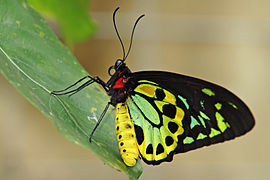Ornithoptera euphorion
| Ornithoptera euphorion | ||||||||||||
|---|---|---|---|---|---|---|---|---|---|---|---|---|

Ornithoptera euphorion , male |
||||||||||||
| Systematics | ||||||||||||
|
||||||||||||
| Scientific name | ||||||||||||
| Ornithoptera euphorion | ||||||||||||
| ( Gray , 1852) |

red: Ornithoptera priamus
green: Ornithoptera Euphorion
purple: Ornithoptera richmondia
Ornithoptera euphorion ( Synonym : Troides euphorion ) is a butterfly from the genus of the bird butterfly ( Ornithoptera ) and the family of the knight butterfly (Papilionidae) that occursin Australia. The species is named after Euphorion from Greek mythology .
features
butterfly
The thorax of both sexes has a black base color. Red hair can be seen in the chest area. The abdomen is colored yellow and has black dots on the sides. Ornithoptera euphorion shows a strong sexual dimorphism .
male
The wingspan of the males is 110 to 130 millimeters. The upper side of the front wing has a black base color and is provided with narrow metallic green stripes on the front and inner edge. There are some light green spots on the black underside of the forewing. A few black spots and yellow stripes stand out from the metallic green upper side of the hind wings. The underside of the hind wings shows a striking pattern of black spots and lines on a turquoise to yellowish background.
female
The wingspan of the females is 140 to 160 millimeters. The upper side of the forewing has a black-brown basic color and is provided with some whitish spots and stripes that shine through to the lower side of the forewing. White and yellow spots stand out in the submarginal area from the upper side of the hind wing, which is also black-brown . These also shine through to the bottom.
Caterpillar
Adult caterpillars are gray-brown to red-brown in color and covered on the entire body surface with strong, straight, thorn-like tubercles . These are ringed orange in the middle. Two tubercles lying roughly in the middle of the body stand out due to their orange-yellow color. In the event of danger, the caterpillars are able to turn out a bright red osmaterium .
Similar species
The moths of Ornithoptera priamus and Ornithoptera richmondia are very difficult to distinguish from Ornithoptera euphorion in terms of their external appearance . However, since Ornithoptera euphorion only occurs in the regions around Cairns and Cooktown , there is no geographical overlap with the similar species.
distribution and habitat
Ornithoptera euphorion is endemic to the regions around the cities of Cairns and Cooktown in Queensland . The species is therefore referred to in English as the Cairns birdwing or Cooktown birdwing . It lives primarily in rainforests, but can also be seen in gardens when visiting flowers.
Taxonomy
Ornithoptera euphorion has long been considered a subspecies of Ornithoptera priamus . Differences in the abdomen, the wing markings and the caterpillar exterior compared to Ornithoptera priamus led to a classification of Ornithoptera euphorion as an independent species. However, since the differences are small, Ornithoptera euphorion is still listed as a subspecies in various literature, as well as Ornithoptera richmondia . Further studies on the species complex Ornithoptera priamus / richmondia / euphorion are required.
Way of life

The moths fly in several generations throughout the year. They like to suckle on flowers for food intake, for example on convertible herb ( Lantana ), hibiscus ( Hibiscus ) and bougainvillea species. The females lay up to 300 eggs individually near the food plants. The caterpillars feed on the leaves of Osterluzeigewächsen (Aristolochiaceae). With these plants they also take up toxins and are avoided by predators like birds. In contrast, the moths are sometimes victims of silk spiders ( Nephila ). The caterpillars are in danger of death if they accidentally eat the leaves of the phantom plant ( Aristolochia littoralis , Syn .: Aristolochia elegans ) brought in from South America via ornamental gardens . The caterpillars cannot tolerate the toxins of this non-native plant species and they die before they are fully grown. Therefore, in Queensland, New South Wales and the Northern Territory, it is now advisable not to plant this species , which belongs to the Neobiota .
Danger
Although Ornithoptera euphorion only occurs in areas that are relatively small and narrowly defined by Australian standards , it is classified as least concern by the Department of Environment and Science of the Queensland Government .
Individual evidence
- ^ A b c Geoff Monteith and Katie Hiller: Birdwing Butterflies Fact Sheet , Queensland Museum, South Brisbane, 2011
- ↑ DL Hancock and Albert George Orr: Ornithoptera euphorion (Gray) (Lepidoptera: Papilionidae): species or subspecies? , Australian Entomologist 24 (4), 1997, pp. 165-168
- ↑ Markku Savela: Tanaecia Butler, [1869] - distribution. In: Lepidoptera and some other life forms. Retrieved January 12, 2019 .
- ↑ Endangerment
Web links
- purvision.com - photos
- lepidoptera.butterflyhouse - caterpillar


